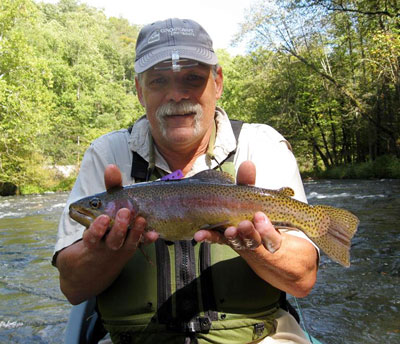 Fall Backcountry Fishing in the Great Smokey Mountains National Park
Fall Backcountry Fishing in the Great Smokey Mountains National Park
By James Lackey
As the leaves start to turn and the temperature starts to cool, fly-fishing in the GSMNP can offer angler a beautiful, but challenging, experience on the streams. Taking a short hike up some of the moderate to small streams that are numerous in the park can get you off the beaten path and provide some excellent fly-fishing opportunities.
As the water begins to cool, trout will become more active. The Browns and the Brookie’s begin to spawn in October. That’s when the largest Browns in the stream will be out and ready for a meal. They like to hang out in the larger pools or slower runs but are still wary and can be spooked easily.
While water temperature cools, low water conditions will make approach and presentation the key to catching native trout in the park. Low water means the trout will be pushed into the pools and runs, so spend time planning your approach. Stay out of the water as much as possible and use your surroundings to blend in like the trees and the rocks. I like to wear dark green or gray and move slowly as I approach each section of water.
Your presentation should be delicate, let the fly land subtle and soft with as much distance as possible. Try to eliminate as much false casting as possible and try to always make your first cast the most accurate. If the trout are hungry, the strike will usually occur in the first two to three casts. Try to keep the flyline off the water as much as possible, use line colors in olive, tan or beige. When it comes to the leader, I like to use a 9 1/2 to 12 ft. 6X or 7X tapered leader, the tippet is light so attach your fly with a good strong knot (I use the improved clinch knot) and when the trout is on, be gentle with the retrieve. Always have a net to land the fish in and try to keep the trout in the water as much as possible.
When it comes to flyrods, I like a 2, 3 or 4 weight light action in 6 1/2 to 8 1/2 ft. length. The Orvis 7 ½ feet Super Fine Touch 2 1/8 oz., 3 weight Full Flex rod with an Orvis BatlenKill BBS reel is a good combination.
As for fly selection, I like to go small this time of year, dry flies anywhere from 16 to 18 and nymphs 14 to 18 in size. I use a dry/dropper technique but usually whatever seems to be getting strikes, the dry or the nymph, I will use exclusively. Flies with yellow or burnt orange work well, I like to use a Number 16 yellow sally with a traditional Tellico nymph size 14 in yellow or burnt orange. Don’t forget the go-to flies like a 16 or 18 parachute Blue winged olive or the same in the Parachute Adams. I also like to drop a size 20 or 22 black or zebra midge especially in the early half of the day. The main thing here is to be versatile, change flies, use different combinations, and find the pattern that is working best. I like to pre-rig a lot of my dry/dropper rigs before I go because the more time you spend tying on flies the less time you spend fishing with them.
Also, when fishing in the backcountry, I like to carry some extra gear, just in case. For example, a light rain jacket, rope, water proof matches, flashlight, a map of the area you are fishing, and water tablets or a small water purifier. It is also a good idea to carry some light food, such as protein bars, nuts, crackers, etc.
Fall in the Great Smokey Mountain National Park is a beautiful time of the year. However, leaves in the water can be a nuisance. I like to put a subtle action on my flies this time of year, especially in areas of the creek that have a lot of floating leaves. Always remember to pre-plan your trip before you go and always let someone know where you are going, when you are leaving, and the estimated time when you should be returning. I also encourage “catch and release” and “leave no trace.”
Tight Lines,
Jimmy
Jimmy Lackey has been fishing in the GSMNP for over 30 years. He is a retired Firefighter and when not guiding, he is fishing somewhere in the park. He considers himself a real life, “Fishhippie”. If you would like to book a trip, contact Hunter Banks in Asheville or Waynesville.
 Fall Backcountry Fishing in the Great Smokey Mountains National Park
Fall Backcountry Fishing in the Great Smokey Mountains National Park